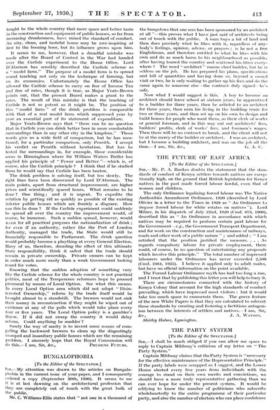THE FUTURE OF EAST AFRICA
[To the Editor of the SPECTATOR.]
Sra,—Mr. P. A. Bankes doubts the statement that the stan- dards of conduct of Kenya settlers towards natives are excep- tionally high, on the ground that British legislation for Kenya natives in the past made forced labour lawful, even that of women and children.
The only Ordinance legalizing forced labour was The Native Authorities Amendment Ordinance, 1920 (described by Lord Olivier in a letter to the Times in 1928 as " An Ordinance to impose forced labour for white estates on natives "). Lord Milner, in Isis dispatch of July 22nd, 1920 (Cmd. 873, 1900), described this as An Ordinance in accordance with which natives may be required to perform certain paid labour for the Government—e.g., the Government Transport Department, and for work on the construction and maintenance of railways, roads and other work of a public nature ; and added : " I am satisfied that the position justified the measure. . . . As regards compulsory labour for private employment, there could, of course, be no question of entertaining any proposals which involve this principle." The total number of impressed labourers under the Ordinance has never exceeded 2,500 (Cmd. 2464, 1925). I believe it applied only to adult males, but have no official information on the point available.
The Forced Labour Ordinance myth has had too long a run, and I trust that by publishing this letter you will help to bury it.
There are circumstances connected with the history of Kenya Colony that account for the high standards of conduct prevailing, which have impressed most visitors : but it would take too much space to enumerate them. The grave featuie of the new White Papers is that they are calculated to subvert those standards by creating and fostering a factitious antagon- ism between the interests of settlers and natives.---I am, Sir,


































 Previous page
Previous page